 |
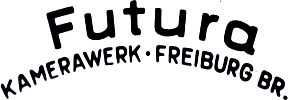
Futura cameras were made by Fritz Kuhnert Optische Anstalt, later Futura Kamerawerk GmbH in Freiburg from around 1950 until 1957. The origins of Fritz Kuhnert's company were in WWII, when it produced optics for the military. He sold the company fairly early in its history (1951) to a shipping company (!) from Hamburg for unclear reasons, suggestions elsewhere on the internet that it was due to mismanagement or financial trouble appear not to be based on any firm evidence. The first camera by the company was the Efka 24 (named using Fritz Kuhnert's initials, as they are pronounced in German), a rather simple square frame viewfinder equipped with an in-house build Elor 40mm f/2.8 lens. Curiously, it did feature a lever wind, which was innovative for the time and was not to appear again until the last Futura model. The first Futura was introduced in 1950. They were high-quality rangefinders with an interchangeable lens mount, which was quite similar to that of the Zeiss Ikon Contax range, i.e., it had a rotating helical focus lens mount. Thus, the lenses had no rangefinder cam, as the rangefinder was connected to the rotating lens mount, and standard lenses had no focus mechanism. As opposed to the Contax bayonet mount, the Futura mount was a 34mm screw mount. The rangefinder itself was of the coincidence type and combined range and viewfinder in a single window.
Futura Standard
The Futura came in several incarnations, although they are all quite similar. The first model, introduced in 1950, was what became known as the Futura Standard. It had the Futura name written in script font between the rangefinder windows and was equipped with Futura's own range of 50mm lenses, including an impressively fast (for the time) 50mm f/1.5 Frilon, designed by a former employee from Schneider. The Standard went through several updates; the first version was characterised by a flash sync socket somewhat hidden behind the rewind knob. For the second version the flash sync was moved from in behind to in front of the rewind knob, and the lettering on the shutter speed dial was inverted so it could easier be read from above.
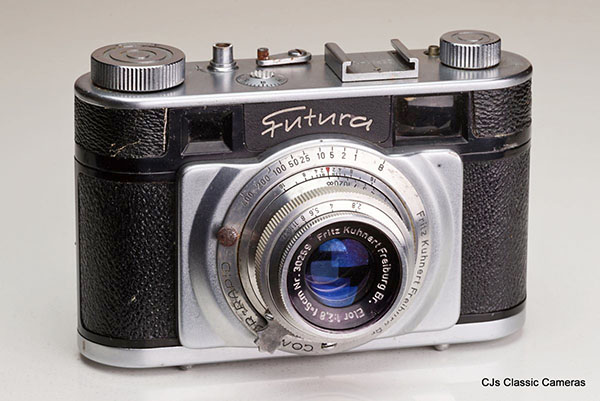
First version of the Futura Standard with Elor 50mm f/2.8 lens in Compur-Rapid shutter.
The second version was also available with a Schneider Xenar 45mm f/2.8 lens in addition to the already existing 50mm lenses. Due to the difference in focal length some changes to the lens mount needed to be made, therefore this version of the Futura Standard was available with mounts marked '45' or '50' on the focus ring (see more on this below in the lens mount section). A few more changes were made during production, e.g., after sale of the company the name on the speed ring changed to 'Futura Gmbh Freiburg Br.', at some point an second stud was added to the speed ring, and the focus lever changed from star-shaped to round.
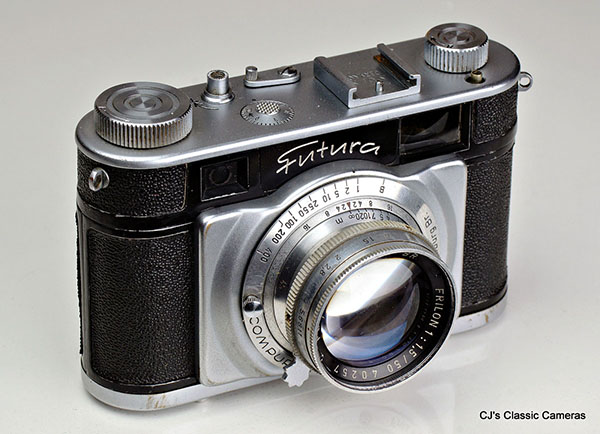
A Futura Standard with Frilon 50mm f/1.5 lens in Compur-Rapid shutter. This is the second version of this model, with flash sync in front of the wind knob. The strap lugs must have been fitted later, as the only model with strap lugs as standard was the Futura-S.
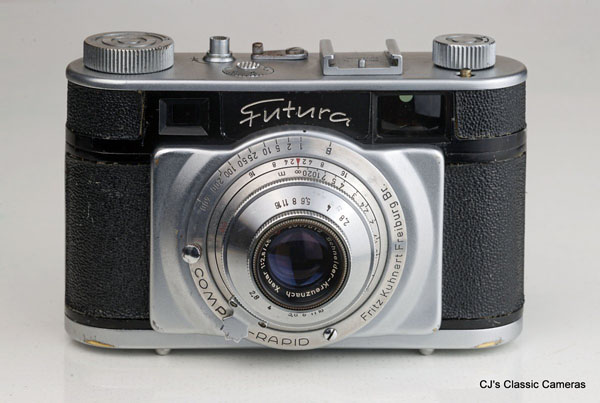
And here is the same version of the Futura Standard but with Schneider-Kreuznach 45mm f/2.8 Xenar, the only non-Futura lens to be available for Futura cameras. It's a little unclear why Futura decided to introduce the Xenar into their line-up; after all, they had their own f/2.8 Elor. But the Xenar was a highly popular lens, so perhaps Futura simply got many requests for this lens and responded to a marketing opportunity.
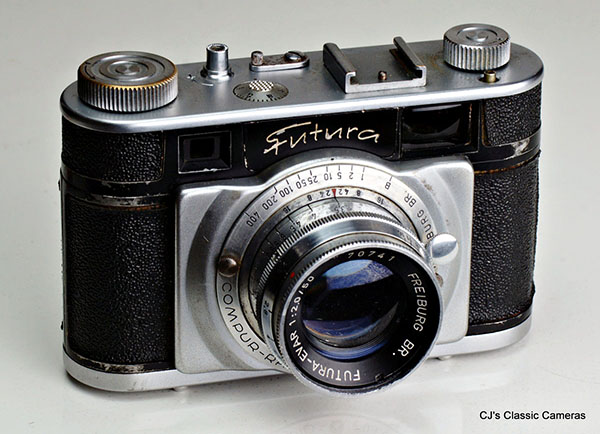
Later production example of the Futura Standard with Evar 50mm f/2.0 lens. This example bears the new company name on the shutter speed ring (Kamerawerk-Freiburg Br. in capitals), has a round focus lever as well as two studs on the shutter speed ring.
The next upgrade in 1952 was mainly cosmetic. The Futura lettering on the front badge was modernised (indeed, very much like the 'Futura' font) and 'Kamerawerk-Freiburg Br.' was painted under the name of the camera at the front instead of engraved in the speed dial (see below under Futura P). I think this was the time when wide and telelenses were introduced, although it is hard to be certain, they may have been available earlier.
Futura P
Soon after the Futura P was introduced, a cheaper variant named after its Prontor-SV shutter, although the name Futura P does not appear on the camera itself. On this model the flash sync moved to the front plate and it appears they all had a 45 mm focus mount for a Schneider Xenar or the newly introduced Futura Futar 45mm f/3.5 lens. Accessory wide and telelenses could be used, but due to the slightly different mount a small spacer was needed. The camera lost the time delay lever on top of the camera, as this functionality was taken over by a lever on the shutter itself.
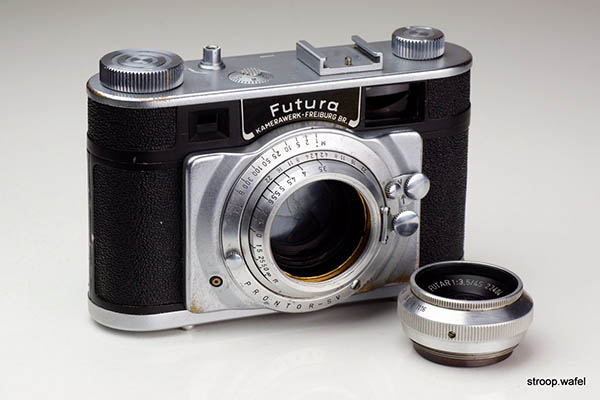
A Futura P with unmounted Futar 45mm f/3.5 lens in Prontor-SVS shutter.
Futura-S/ Futura S-III
The last major upgrade was the Futura-S in 1953, which had a Synchro-Compur shutter and an updated lens mount which allowed full coupling of wide and telelenses to the rangefinder (see below for details). The front of the camera was modernised, with a metal nameplate and the name of the company moving to the shutter speed dial once again. The camera also finally got some strap lugs. A special version was the SIII, introduced in 1956, which had a lever wind instead of a wind knob, although this was already available as an option on the Futura-S. It appears that the SIII was an export version for the USA only. Perhaps it was simply introduced to raise new interest in the brand, as not much had happened since the introduction of the Futura-S three years earlier.
By 1957 the company ceased trading, probably because the development of Futura cameras had not really kept up with that of its competitors and large investment would have been needed to keep the company going. A prototype of a new model was shown at photography fairs in late 1956, but this never came into production.
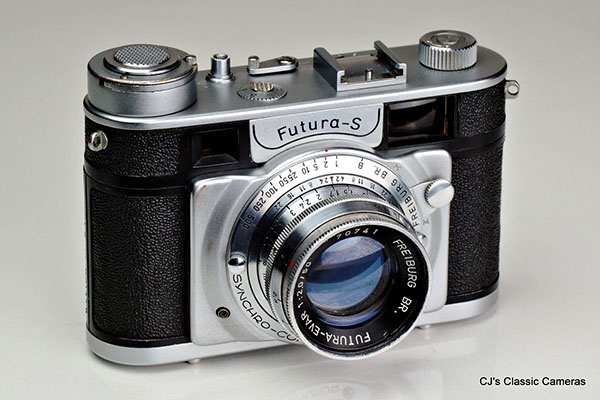
A Futura S with Futura-Evar 50mm f/2 lens in Synchro-Compur shutter. Note that this example has the optional rapid wind lever fitted, so is essentially identical to the Futura-SIII other than the nameplate.
Some more about the Futura lenses, as this is one of the most interesting aspects of the brand. The first lenses were made when the company was still owned by Kuhnert, as they were marked 'Fritz Kuhnert Freiburg Br.'. The lenses came in three different speeds, the six-element Frilon (50mm f/1.5), the five-element Evar (50 mm f/2) and the four-element Elor (50mm f/2.8). These early 'Fritz Kuhnert' versions are relatively rare, as the name was changed to Futura Freiburg Br early on, after sale of the company in 1951. An interesting detail is that the lenses were named after Kuhnert's family, his wife Eleonore (Elor) and his children Eva (Evar) and Peter (Petar, or so the story goes, I've never seen a lens of that name), and presumably Frilon was named after Fritz himself. The Evar was renamed Futura-Evar around 1953, but for some reason none of the other standard lenses were, even though it appears they were still in production. The only other lens for which I have seen a similar name change was the wide-angle Ampligon, but in that case also the mount changed (see below). A fourth standard lens was the Futar (45mm f/3.5), most likely introduced around the time of the Futura-P.
Futura lens mount
It is worth noting that the Futar as well as the Xenar had a different focal length than the other lenses (45 vs 50mm); this may seem irrelevant, but as all these lenses were mounted on the same focussing helicoid, and the helicoid can only be accurate for one particular focal length, this meant that the 45mm and 50mm lenses were not really interchangeable (see here for a similar issue related to Nikon and Contax lenses). Therefore, other than the very first version of the Futura Standard, Futuras came with a focal length indicator on their mount (marked on the focus ring). Interestingly, the difference between these was not in the helicoid itself, just in the focus scale marked on it (see photo below). This means that the internal rangefinder cam for these mounts must be different (or, less likely, the rangefinder itself).
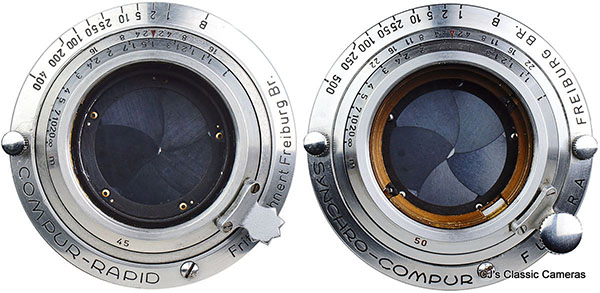
Comparison of 45mm (left) and 50mm (right) helical focus lens mounts (from Futura Standard and Futura-S, respectively). Note the slight difference in focus scales: a 90-degree turn focusses to about 1.45m on the 45mm mount, whereas it goes to 1.65 on the 50mm mount. As the movement perpendicular to the film plane is identical, this means the 45mm mount extends less to reach the same focal point, as is expected for a shorter focal length.
The photo also illustrates several differences between early and late Futuras, such as the shape of the focus lever, company name on the speed ring and number of studs on the speed ring. Also note the brass insert in the shutter on the Futura-S mount, which facilitates the RF coupling with the telelenses (see below for details).
Futura wide and telelenses
In addition to the standard lens line-up a range of other focal lengths was available (plus a range of accessories), making the Futura a real system camera. The line-up comprised the 35mm f/4.5 Ampligon, the awesome and nowadays incredibly hard to find 70mm f/1.5 Frilon, the 75mm f/3.8 Tele-Futar and the 90mm f/5.6 Tele-Elor. Coupling these lenses to the rangefinder presented a problem for cameras with helical focus mounts, already well known from the Zeiss Contax, which had a rather awkward, separate outside bayonet mount in additional to its helical mount. Futura had a different solution: the non-standard lenses would simply screw onto the helical mount but needed to be focussed manually, after finding the focus distance using the rangefinder, and then turning the helical mount back to infinity.
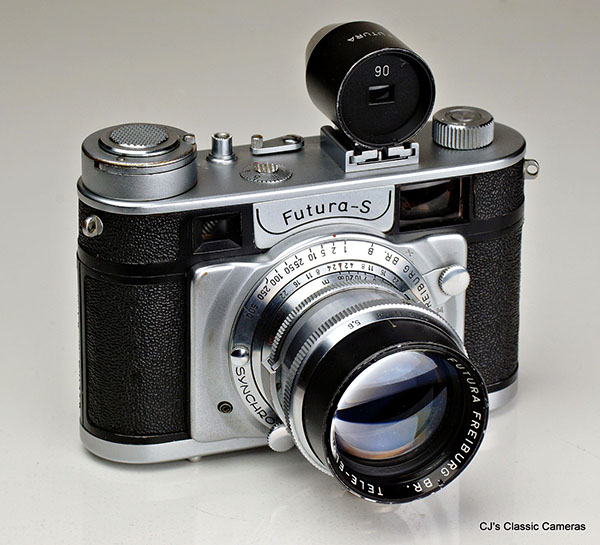
Same Futura-S fitted with a Tele-Elor 90mm f/5.6 lens and accessory viewfinder.
Futura must have understood this was cumbersome, as on the Futura-S they introduced an updated lens mount which had an indent which would mate with a notch on the lens base of wide and telelenses, which were all redesigned. The result was that when one turned the focussing helicoid, the helicoid internal to the lens would turn by an equal amount, so that the lens would extend even more (in case of the telelenses). The lenses are recognisable by a ring at the base of the lens which allowed screwing it onto the lens mount whilst keeping it in a fixed position. It required a complete redesign of the focussing helicoid of the lenses, as the early style lenses were focussed turning counter-clockwise and it took a close to a full rotation to go from infinity to the closest focus distance, whereas on the later RF-coupled version the rotation needed to be clockwise and had a much shorter turn. The RF coupled versions of the lenses lack a focus scale as well as depth of field indicators. The two lens systems are not really interchangeable; the RF coupled lenses will fit on older Futura models, but cannot be properly focussed. I am not sure why Futura did not have a focussing scale on the latter version for backwards compatibility, I assume because it would indicate the wrong value on the RF-coupled mount, as on the older model the mount needed to be set to infinity for the lens to focus correctly, whereas on the RF-coupled mount of course it did not. Likewise, old style lenses cannot be used properly on the Futura-S, they cannot be focussed to infinity as the rear mount is slightly too wide for the insert in the Futura-S mount unsed for rangefinder coupling. Note that for the wide and tele-lenses to be used on the Futura-P (with its 45mm focus mount), a small spacer needed to be added to avoid focus errors.
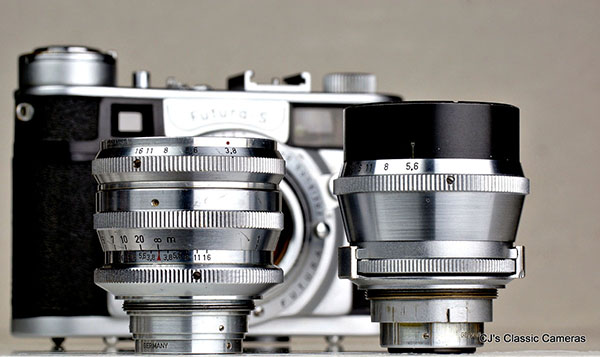
Comparison of early style lens without RF coupling (a 75mm f/3.8 Tele-Futar) on the left and a later RF-coupled lens (a 90mm f/5.6 Tele-Elor). Note the early lens had distance indicators, as its focus needs to be adjusted manually, whereas the late lens did not, as its focus was coupled to that of the focussing mount. Other than by the lack of a focus scale, late lenses can be recognised by the ring near the bottom used to secure the lens onto the lens mount.
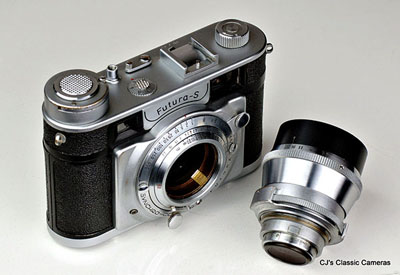
|
Lens mount of the Futura S, showing the indent in the focus mount which mates with a notch in the base of the lens, also shown.
|
A final note on the serial numbers of the Futura lenses, which are five digit numbers except for the two telelenses, which have four digits preceded by the letter T. It appears that each lens, and each new version of it, had a unique first digit, so Frilon start with '4', Ampligon with '1', Futura-Ampligon with '6', and so on. The exception is that Evar and Elor lenses both have numbers starting with '3', although it appears all Evar are higher than 35000 and all Elor are lower. The system for the telelenses is a bit unclear, it appears early Tele-Futar started with 'T1', where the later RF coupled version started with 'T3', similarly the two Tele-Elor versions started with 'T5' and 'T7', respectively, but continued to higher values, so lenses starting with 'T8' can also be found.
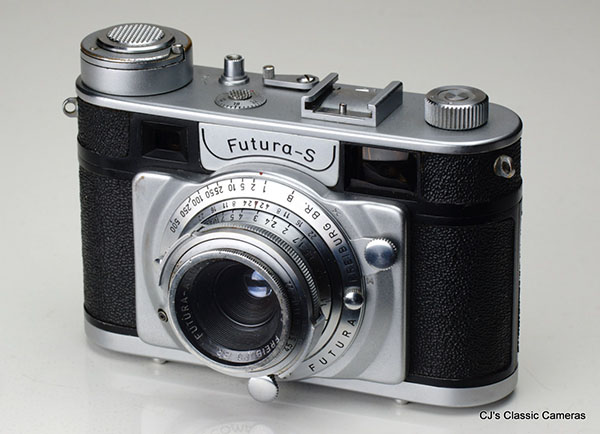
A Futura S with the rather tiny Futura-Ampligon 35mm f/4.5 lens mounted. This is the late, RF coupled version of the lens.
Futura repairs
A few notes about servicing Futuras, which is a little harder than some other cameras, as getting to the range/viewfinder glass requires taking quite a bit of the top of the camera apart, and getting to the shutter means removing the lens mount.
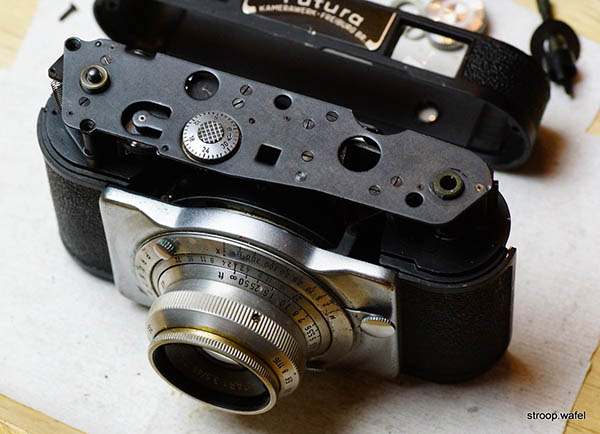
Removing the top plate of the Futura P does not help much with getting to its insides. One also needs to remove the cover containing the viewfinder, which is attached with a small screw at both ends.
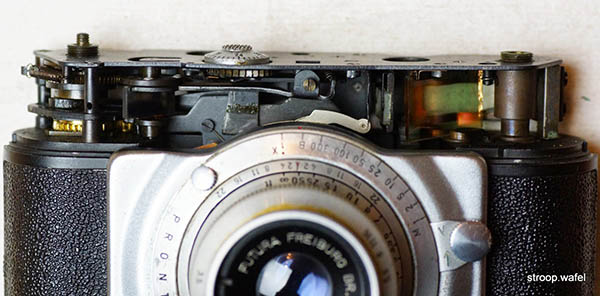
Front view after removing the top cover. The small screw in the middle just below the top plate allows horizontal adjustment of the rangefinder. The vertical can be adjusted with the screws that hold in place the bottom of the semi-transparent mirror (gold-covered glass on the right).
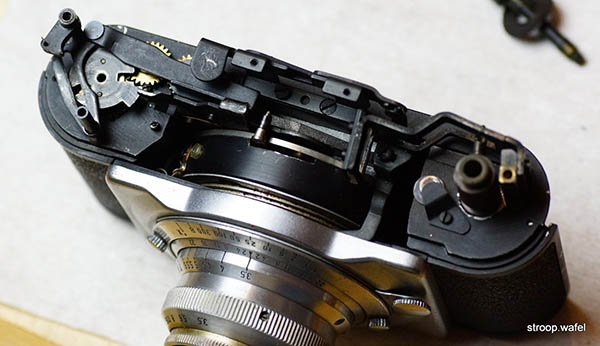
Removing the top plate, which holds most of the wind mechanism and rangefinder assembly, exposes the shutter cocking and release mechanism. The shutter is set quite far back in the body.
|

